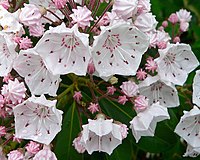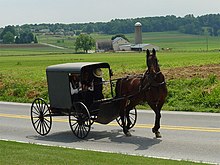Portal:Pennsylvania
The Pennsylvania Portal Pennsylvania (/ˌpɛnsɪlˈveɪniə/ ⓘ, lit. 'Penn's forest country'), officially the Commonwealth of Pennsylvania (Pennsylvania Dutch: Pennsylvanie), is a state spanning the Mid-Atlantic, Northeastern, Appalachian, and Great Lakes regions of the United States. Pennsylvania borders Delaware to its southeast, Maryland to its south, West Virginia to its southwest, Ohio and the Ohio River to its west, Lake Erie and New York to its north, the Delaware River and New Jersey to its east, and the Canadian province of Ontario to its northwest. Pennsylvania is the fifth-most populous state in the United States, with over 13 million residents as of the 2020 United States census. The state is the 33rd-largest by area and has the ninth-highest population density among all states. The largest metropolitan statistical area (MSA) is the southeastern Delaware Valley, which includes and surrounds Philadelphia, the state's largest and nation's sixth-most populous city. The second-largest metropolitan area, Greater Pittsburgh, is centered in and around Pittsburgh, the state's second-largest city. The state's subsequent five most populous cities are Allentown, Reading, Erie, Scranton, and Bethlehem. The state capital is Harrisburg. Pennsylvania's geography is highly diverse. The Appalachian Mountains run through the center of the state; the Allegheny and Pocono mountains span much of Northeastern Pennsylvania; close to 60% of the state is forested. While it has only 140 miles (225 km) of waterfront along Lake Erie and the Delaware River, Pennsylvania has the most navigable rivers of any state in the nation, including the Allegheny, Delaware, Genesee, Ohio, Schuylkill, Susquehanna, and others. (Full article...) This is a Featured article, which represents some of the best content on English Wikipedia..
Rachel Louise Carson (May 27, 1907 – April 14, 1964) was an American marine biologist, writer, and conservationist whose sea trilogy (1941–1955) and book Silent Spring (1962) are credited with advancing marine conservation and the global environmental movement. Carson began her career as an aquatic biologist in the U.S. Bureau of Fisheries, and became a full-time nature writer in the 1950s. Her widely praised 1951 bestseller The Sea Around Us won her a U.S. National Book Award, recognition as a gifted writer and financial security. Her next book, The Edge of the Sea , and the post-war reissued version of her first book, Under the Sea Wind, were also bestsellers. This sea trilogy explores the whole of ocean life from the shores to the depths. (Full article...)Selected geography article -
Pennsylvania Route 463 (PA 463) is a 12.9-mile-long (20.8 km) state highway completely in Montgomery County, Pennsylvania. Its western terminus is at PA 63 in Hatfield Township and its eastern terminus is at PA 611 in Horsham. PA 463 runs through the northern suburbs of Philadelphia and passes through the towns of Hatfield, Montgomeryville, and Horsham. The route intersects PA 309, U.S. Route 202 Business (US 202 Bus.), and US 202 in Montgomeryville and PA 152 in Prospectville. Through its length, the route carries the names Forty Foot Road, Broad Street, Main Street, Cowpath Road, and Horsham Road. PA 463 was designated in 1928 and fully paved by 1940. In 2010, a portion of the route in Montgomery Township was widened. (Full article...)
Selected image -Did you know -
Related portalsWikiprojectsThis is a Good article, an article that meets a core set of high editorial standards.
 Forbes Field was a baseball park in the Oakland neighborhood of Pittsburgh, Pennsylvania, from 1909 to June 28, 1970. It was the third home of the Pittsburgh Pirates, the city's Major League Baseball (MLB) team, and the first home of the Pittsburgh Steelers, the city's National Football League (NFL) franchise. From 1909 to 1924, the stadium also served as the home football field for the University of Pittsburgh "Pitt" Panthers. The stadium sat on Forbes Avenue, named for British general John Forbes, who fought in the French and Indian War and named the city in 1758. The US$1 million ($33.9 million today) project was launched by Pittsburgh Pirates' owner Barney Dreyfuss to replace his franchise's second home, Exposition Park. The stadium was made of concrete and steel, the first such stadium in the National League and third in Major League Baseball, in a bid to be more durable than wooden ballparks. The Pirates opened Forbes Field on June 30, 1909, against the Chicago Cubs, and played the final game against the Cubs on June 28, 1970. The field itself featured a large playing surface, with the batting cage placed in the deepest part of center field during games. Seating was altered multiple times throughout the stadium's life; at times fans were permitted to sit on the grass in the outfield during overflow crowds. The Pirates won three World Series while at Forbes Field; the Pittsburgh Panthers football team had five undefeated seasons before moving in 1924. In 1958, broadcaster Bob Prince dubbed Forbes Field "The House of Thrills" for the then-resurgent Pirates and several games that saw late-inning heroics. (Full article...)Selected article -The Amish (/ˈɑːmɪʃ/; Pennsylvania German: Amisch; German: Amische), formally the Old Order Amish, are a group of traditionalist Anabaptist Christian church fellowships with Swiss German and Alsatian origins. As they maintain a degree of separation from surrounding populations, and hold their faith in common, the Amish have been described by certain scholars as an ethnoreligious group, combining features of an ethnicity and a Christian denomination. The Amish are closely related to Old Order Mennonites and Conservative Mennonites—denominations that are also a part of Anabaptist Christianity. The Amish are known for simple living, plain dress, Christian pacifism, and slowness to adopt many conveniences of modern technology, with a view neither to interrupt family time, nor replace face-to-face conversations whenever possible, and a view to maintain self-sufficiency. The Amish value rural life, manual labor, humility and Gelassenheit (submission to God's will). The Amish church began with a schism in Switzerland within a group of Swiss and Alsatian Mennonite Anabaptists in 1693 led by Jakob Ammann. Those who followed Ammann became known as Amish. In the second half of the 19th century, the Amish divided into Old Order Amish and Amish Mennonites; the latter do not abstain from using motor cars, whereas the Old Order Amish retained much of their traditional culture. When people refer to the Amish today, they normally refer to the Old Order Amish, though there are other subgroups of Amish. The Amish fall into three main subgroups—the Old Order Amish, the New Order Amish, and the Beachy Amish—all of whom wear plain dress and live their life according to the Bible as codified in their church's Ordnung. The Old Order Amish and New Order Amish conduct their worship in German, speak Pennsylvania Dutch, and use buggies for transportation, in contrast to the Beachy Amish who use modern technology (inclusive of motor cars) and conduct worship in the local language of the area in which they reside. Both the New Order Amish and the Beachy Amish emphasize the New Birth, evangelize to seek converts, and have Sunday Schools. (Full article...)Pennsylvania news
CategoriesState factsState Facts
State symbols
Pennsylvania topicsGeneral imagesThe following are images from various Pennsylvania-related articles on Wikipedia.
Associated WikimediaThe following Wikimedia Foundation sister projects provide more on this subject:
Discover Wikipedia using portals |
- Pages using the Phonos extension
- Portals with untriaged subpages from June 2018
- All portals with untriaged subpages
- All portals
- Portals with no named maintainer
- Pages including recorded pronunciations
- Random portal component with 6–10 available image subpages
- Random portal component with 31–40 available subpages
- Pennsylvania portal
- United States portals by state or territory
- WikiProject Pennsylvania
- Pennsylvania
































































